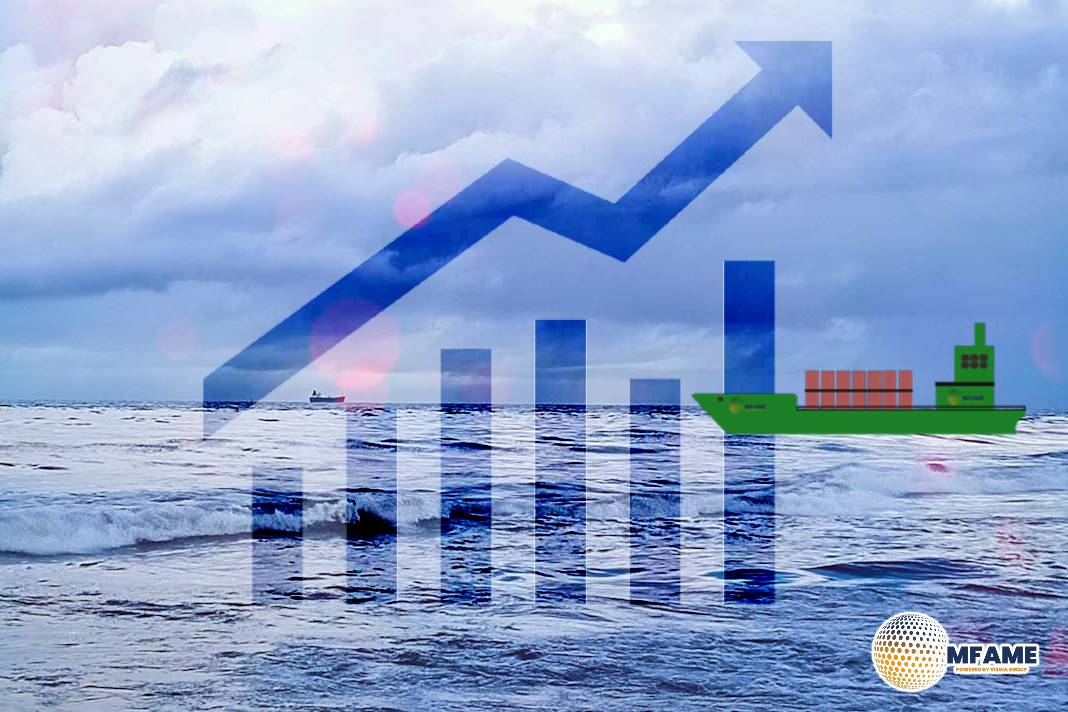Risks to container ships and their crews are escalating by the day in the Red Sea — and with that rising danger comes the prospect of higher shipping rates, reports Freight Waves.
Consequences
Amid Friday’s attacks and growing evidence of route delays and diversions, the share price of ocean carrier Zim (NYSE: ZIM) spiked 18% more than quadruple the average trading volume. Shares of Hapag-Lloyd surged 16%. Maersk’s stock closed up 8%.
It’s yet another example of how bad things — wars, viruses, weather disasters — can equate to potential upside for shipping, or at least, the perception of future upside.
“Approximately 30% of container volumes transit the Suez Canal and make up about half the traffic through the canal by weight,” said Stifel analyst Ben Nolan on Friday. “Rate increases are often announced but not usually successful in a loose market. However, if ships do avoid the Suez Canal, the market could easily tighten enough to support the rate increase.”
Attacks target ships of Maersk, Hapag-Lloyd, MSC
More container ships are expected to divert to the much longer route around Africa’s Cape of Good Hope, given the threat at the Bab-el-Mandab Strait in the Red Sea. The big question is whether current ad hoc ship diversions will translate into sustained service reroutings.
Longer routes require more ships to maintain weekly service, which can offset some of the current rate pressure due to new building deliveries.
Yemen’s Houthi rebels hit the OOCL-chartered vessel Number 9 on Dec. 3. On Thursday, the Houthis fired a missile at the Maersk Gibraltar. They attacked Hapag-Lloyd’s Al Jasrah and Mediterranean Shipping Co.’s MSC Palatium III on Friday.
“Following the near-miss incident involving Maersk Gibraltar yesterday and yet another attack on a container vessel today, we have instructed all Maersk vessels in the area bound to pass through the Bab al-Mandab Strait to pause their journey until further notice,” said Maersk.
Hapag-Lloyd also paused transits through the strait on Friday. CMA CGM followed suit on Saturday. MSC, the world’s largest liner operator, said Saturday that the MSC Palatium III has been removed from service due to fire damage and that all MSC transits of the Suez have been canceled, with some MSC ships already rerouted around the Cape of Good Hope.
Both Asia-Europe and Asia-US markets exposed
The Asia-Europe and Asia-U.S. trades are the world’s two largest container shipping markets. The Asia-Europe market is directly affected by security issues at the Bab al-Mandab Strait, and the Asia-U.S. trade is much more affected now than it would be normally.
Panama Canal transit restrictions due to low water levels began heavily curtailing transits of larger container ships in November. In response, multiple Asia-U.S. services have already diverted from Panama to the Suez Canal.
Now, some of those ships that diverted to the Suez Canal may divert yet again, to the Cape of Good Hope.
The voyage between Shanghai and New York is 17% longer via the Suez Canal than the Panama Canal, and 37% longer via the Cape of Good Hope than the Panama Canal, according to distance calculator Sea-Distances.org.
Some ships in the Asia-Europe trade will also divert around the Cape. The distance between Shanghai and Rotterdam, Netherlands, is 32% longer via the Cape of Good Hope than via the Suez Canal.
The voyage from Shanghai to Rotterdam is longer going westward and using the Cape than going eastward and using the Panama Canal, traversing both the Pacific and Atlantic oceans.
Asia-Europe rates rising in December
The situation for container lines looked particularly dire only a few weeks ago.
Many Asia-Europe annual contracts renew on Jan. 1. Spot rates were exceptionally weak in October and November. If spot rates didn’t improve very soon, annual contracts would likely reset much lower.
The good news for ocean carriers is that Asia-Europe spot rates are up significantly this month, even before the potential upside from the latest events in the Red Sea. Spot rates are still relatively weak, but they’re much improved from October and November, enhancing carriers’ negotiating hand in contract talks.
The Freightos Baltic Daily Index (FBX) for China to the Mediterranean has risen 73% from late October through Thursday, to $2,367 per forty-foot equivalent unit. The FBX China-North Europe Index is at $1,461 per FEU, up 37% over the same period.
The Drewry World Container Index (WCI) for Shanghai to Genoa, Italy, has risen 44% between late October and the week ending Thursday, to $1,697 per FEU. The WCI assessment for Shanghai to Rotterdam is at $1,442 per FEU, up 26%.
The more container ships that divert around the Cape of Good Hope, the better the prospects for both spot and contract rates in the Asia-Europe market — as well as the trans-Pacific market, courtesy of Panama’s travails.
Container-ship lessors could also benefit
It’s not just container freight rates that stand to gain from Red Sea disruptions. The need for more ships to serve longer routes could also support future demand and leasing rates in the ship charter market.
“The problematic situation in the Red Sea and the resulting ad hoc vessel diversions to the Cape route have not yet led to a notable increase in tonnage demand,” said Alphaliner on Tuesday. “[But] should these problems continue into 2024, they will certainly boost tonnage demand, since carriers will have to factor these longer trips into their schedules and fleets.”
Commenting on ship-chartering prospects for next year, Alphaliner said, “The outlook for the market in 2024 is uncertain, considering the large number of new buildings of all sizes due to hit the water.
Did you subscribe to our daily Newsletter?
It’s Free! Click here to Subscribe
Source: Freight Waves



















